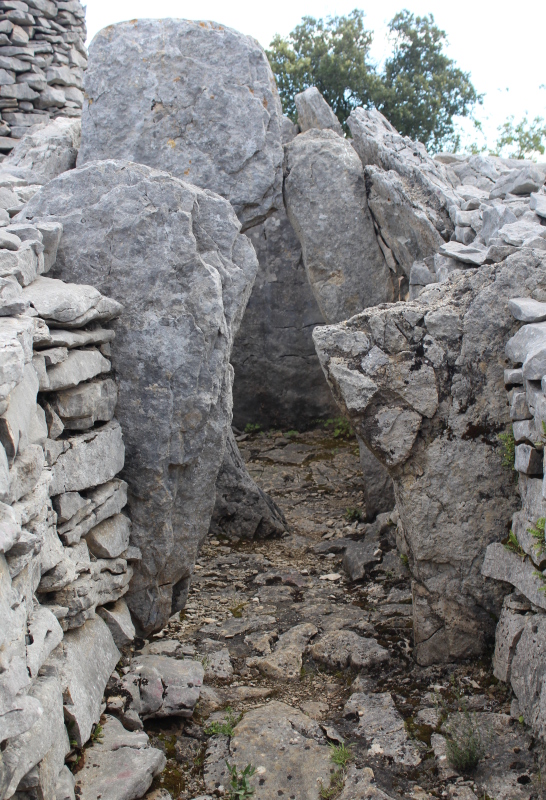

The detatched capstone .

A couple of hundred metes to west of the dolmen ,good view down the Gorge de Vis .

Ante chamber .Walling used for antechamber and chamber but passage has orthostats .

The secondary chamber .

Ante chamber with curved /indented orthostat on right and small blocking/retaining stone at entrance .

Looking from the passage entrance the chamber is wider than ante chamber and extends to left , what is usually described as a q design (as opposed to a p which would extend to the right ) .

Entrance stones to chamber looking out into ante chamber .

Entrance to ante chamber , indented /curved stone is on opposite side to the one at the chamber entrance .

Passage orientation differs by approx. 6 degrees from that of chamber and ante chamber .

Chamber entrance .

Entrance to chamber , note indented/curved stone .

Backstone with narrower top allowing for sidestones to lean inwards as is common in more simple Languedocian dolmens . It was once thought that the sloping side stones were due to pressure from the surrounding tumulus , excavators have challenged this idea .
The Lamalou dolmen is one of small group of very similar monuments on the Causse de l’Hortus .They all have square or trapezoidal chambers , an adjoining ante chamber ,which tends to be smaller ,a long passage , indented slabs at entrances , dry stone walling and large cairns . The orientations are similar ,between 246 -256 degrees but the declinations are all quite different with nothing astro or landscapewise in common .Despite the presence of small but prominent hills on their horizons e.g. Pic St Loup etc , they are avoided .

Chmaber entrance looking out .

Entrance to ante chamber .

Entrance to chamber from ante chamber , both entrance stones indented .

Angled backstone allows side slabs to be angled inwards as found with more typical simple dolemns without a covering cairn .

Ante chamber entrance , note indented slab .
At over 625 m above sea level it’s much higher than any UK stone circle and has a diameter close to that of Brodgar ,only Avebury and Stanton Drew are greater in diameter . So not a bijou upland stone circle .
What looks like portal stones ,might be considered to be due to the gaps around them , but they are the only two stones that are actually closer to the central stone , so there is a case for them being seen as portals . The rest maintain quite a regular radius .
Worth mentioning a prominent rock to the south east , it’s framed by the portal stones but not in their frame when viewed from the central stone .Of the three options centre stone to rock , centre of portals to rock and centre stone through portal stones the first is close enough to be considered a winter solstice sunrise alignment .with the last a long way off .
I’m not much of a fan of moderns imposing names on monuments or features , it detracts and only tells of the thinking of the namer . But this one is only one of many and probably won’t be visited too often . So a small dedication to a cause . When passing in the future it will either signify relief and the slaying of dragons or a sense of waste .I’m hoping and expecting the former .
The important stuff: 21 cups on the section in the pics , a couple of metres away are another 11 but they proved almost impossible to capture .
p.s. It was found on the day of the vote .




























